VOL.52, NO. 1
Speaking Through Her: Christine Jeffs’ Sylvia and the ongoing misinterpretation of Sylvia Plath
Rosalind Moran
Forty years after her suicide, iconic author Sylvia Plath was immortalized onscreen in the 2003 film Sylvia. The film purports to be a biopic: from its all-encompassing title to its quoting of Plath’s poetry, it implies its own veracity and consequent value as a biographical depiction of Plath’s life. Sylvia, however, merits study not for its quality or historical accuracy – being lacking in both – but rather for the way it adapts reality. The film is an interpretation of real people and their writing; what director Christine Jeffs chooses to include or omit about them, therefore, both reflects and contributes to how Plath and her work is understood. This truth is evident in aspects of the film ranging from paratexts and casting, to the centrality and stereotypes of the ‘love’ story, to the film’s voyeurism. Indeed, considering Sylvia’s potential for misrepresenting reality, one wonders why it was made at all – and what its existence says about both Plath’s endurance and her audience. Studying the film can nevertheless be illuminating, however, for doing so can reveal the film’s worth insofar as it (mis)represents Plath, deliberately and otherwise, as well as help unearth further patterns and fallacies in how Plath is remembered and understood.
The messages Sylvia sends about its subject begin with the film’s paratexts. The use of genre labels, taglines, and posters in marketing all contribute to how the film is received. They potentially also influenced the film’s production: pitching the film’s premise in the pre- production stage may have involved defining its target audience and genre, thus imposing the limitations of expectations on the film from the outset. Sylvia’s genres are commonly perceived to be “Biography, Drama, Romance”: such categorization asserts the film’s veracity through the first genre listed, then manipulates the audience’s expectations of the film through the second and third (Sylvia movie posters, 2003). Posters for the film operate similarly, with many featuring enigmatic close-up shots of the character of Plath, suggesting the film’s focus is on her interiority (Sylvia movie posters (e.g. Japanese, South Korean, Spanish, Swedish, Taiwanese, United States), 2003). Yet this suggestion could be construed as misleading considering the film’s actual content. Indeed, posters alternating from this model typically show the characters of Plath and Ted Hughes together, either sharing a kiss or locked in a nude embrace, which is far more in keeping with the film’s mainstream romance backbone (Focus Features, 2003). Such images indicate the couple’s relationship is at the center of the film – a telling visual clue, considering the film’s title suggests its content focuses on Sylvia, not Sylvia and Ted.
The film’s tagline “A passion beyond words” also encourages assumptions of a love story being central (Sylvia United States movie poster, 2003 [see Figure 1]). That audiences are encouraged to perceive a love story as pivotal within a film about Plath, however, is concerning, for it insinuates Plath’s relationship with Hughes was foundational within her life as well. This is a reductive perspective, as will be explored in more depth shortly; the Plath of Sylvia is but a two-dimensional imitation of the real person, and not only because she is flattened by film.
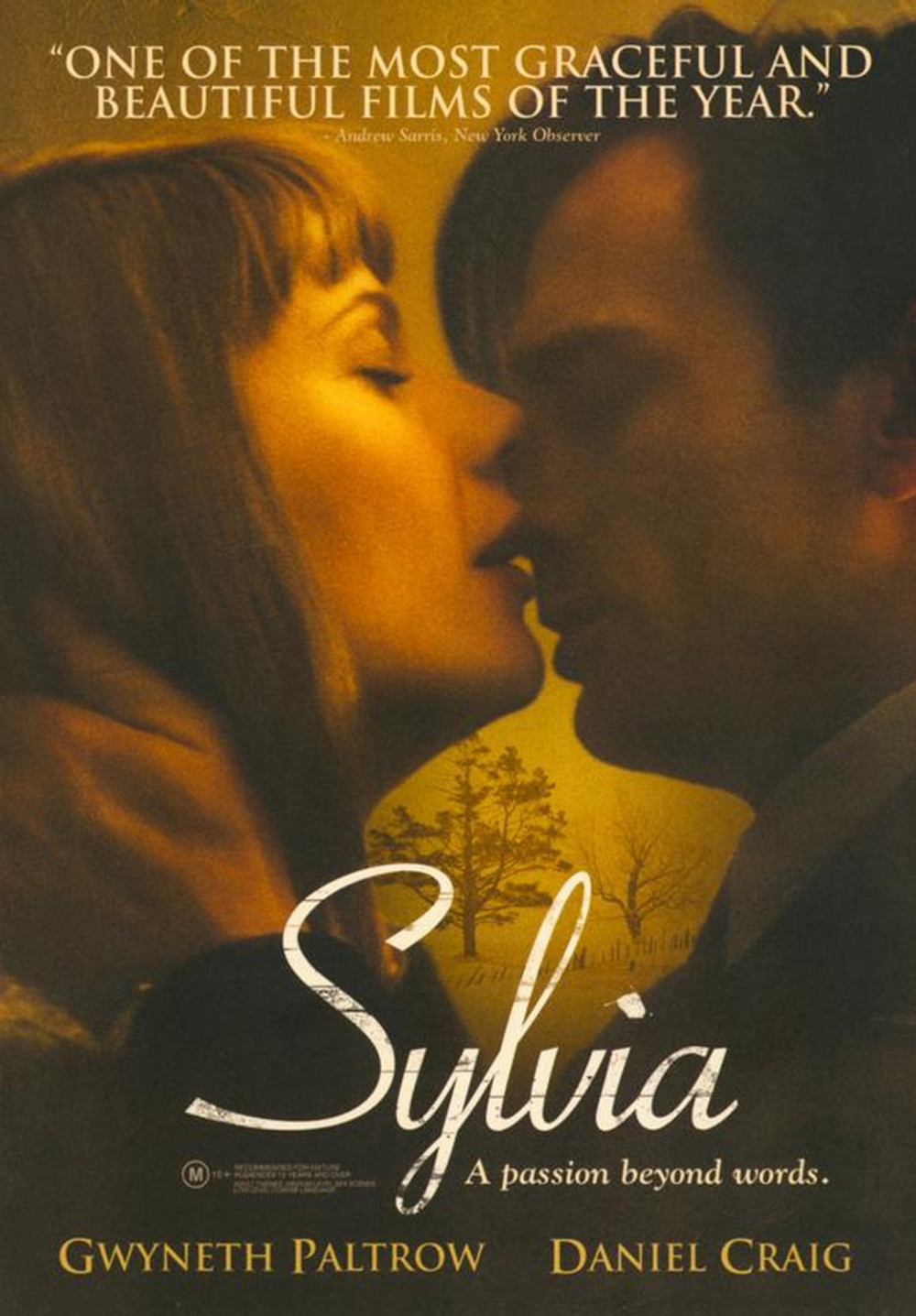
The simplistic nature of Plath’s portrayal in Sylvia is due partly to casting. Gwyneth Paltrow plays the titular lead, bringing with her associations of Hollywood and period films, having starred in productions like Emma, Great Expectations, and Shakespeare in Love (McGrath 1996; Cuarón 1998; Madden 1998). Indeed, the love stories central to such films would motivate audiences of Sylvia to expect another romance and thus perceive the film and its subject through that lens. This is especially true considering Paltrow was best-known at the time of Sylvia’s release for her Academy Award-winning performance as half of the star-crossed romance in Shakespeare in Love. It is likely Jeffs and Focus Features rationalized such casting by emphasizing Paltrow’s celebrity magnetism for viewers; such a marketing-based consideration is an inevitable part of film production. Nevertheless, one could argue critics are wrong in deeming the film “well-cast” (Ebert 2003): although Paltrow’s star power potentially rendered Sylvia more commercially successful than it might otherwise have been, casting an unknown as Plath may have created less bias in understandings of the film. The very fact Paltrow is recognizable means Plath’s identity in the film is superimposed onto pre-conceived ideas of who “Sylvia” might be. Thus, the film may actually distance viewers from Plath’s reality, as opposed to allowing them insight into it through the film’s supposedly biographical nature.
Paltrow’s casting as Plath is also worth examining due to what it suggests about how Jeffs wishes audiences to understand the poet. Paltrow, for example, is blonde both in and beyond the film. Critics such as Roger Ebert believe this makes her physically suitable for the role of Plath, claiming she “look[s] something like the original” (ibid.). This view is echoed in the writing of scholar Tracy Brain, who describes how Paltrow’s hair and makeup is styled for Sylvia “so that the actress resembles Plath as closely as possible,” in keeping with the film’s supposedly biopic nature (Brain 184). Yet the irony of such arguments is that they are unwittingly entirely false. Plath was not naturally “the blonde ideal, 24-7” (O’Sullivan 61): she “bleached” her hair to achieve the glamorous look immortalized in her swimsuit photos, and spent most of her adult life as a brunette (Kukil and Steinberg 627). Dyeing her hair, moreover, was a deliberate attempt to “brighten her image” following her first suicide attempt and hospitalization; it was arguably not representative of her identity, but rather of an extension of the “all-American girl” persona she sought to project (LeFebvre 2017). Consequently, the fact Sylvia depicts Plath as blonde shows that the film adheres – consciously or otherwise – less to the truth of who Plath was, and more to an image both she and society constructed.
Sylvia further forms and responds to reception of its subjects through its portrayal of Hughes. The man Plath described as “colossal” (Plath and Kukil 212) and Philip Larkin wrote resembled “a Christmas present from Easter Island” (Larkin 318) is represented onscreen by Daniel Craig, who is a mere 5’10” tall and lacks Hughes’s intimidating brick-jawed physicality (Craig 2017). Indeed, one could argue the film replaces Hughes’s “violent, virile body”14 with a figure more conventionally attractive and less threatening than Hughes was reported to be in reality, both in looks and in behavior (Plath and Kukil 570). Such a directorial choice is significant, for it is in keeping with the hypothesis that the film downplays Hughes’s violence and wrongdoings in relation to Plath, much as has the Hughes Estate (Kean 2017). This contributes to the promotion of a misleading representation of the pair’s relationship.
Inaccurate and potentially biased representation of the pair’s relationship is evident even in the film’s narrative structure. Similar to the film’s paratexts, Sylvia’s structure implies that Plath cannot be examined without Hughes being examined as well; that she cannot exist – either literally or in memory – without her husband. This limiting attitude is displayed even by the fact that Plath’s first encounter with Hughes, “now one of the most famous in all literary history” (Wilson 3), occurs a mere three minutes into the film. Moreover, the film ends with Hughes and his reaction to Plath’s death; his melancholy face looks out at a snowy scene through a window with a frame shaped like prison cell bars (see Figure 2). This shot stands in stark contrast to the one in which Hughes stands at an open sun-kissed window with Frieda Hughes after her birth, back when his relationship with Plath still appeared full of possibilities.
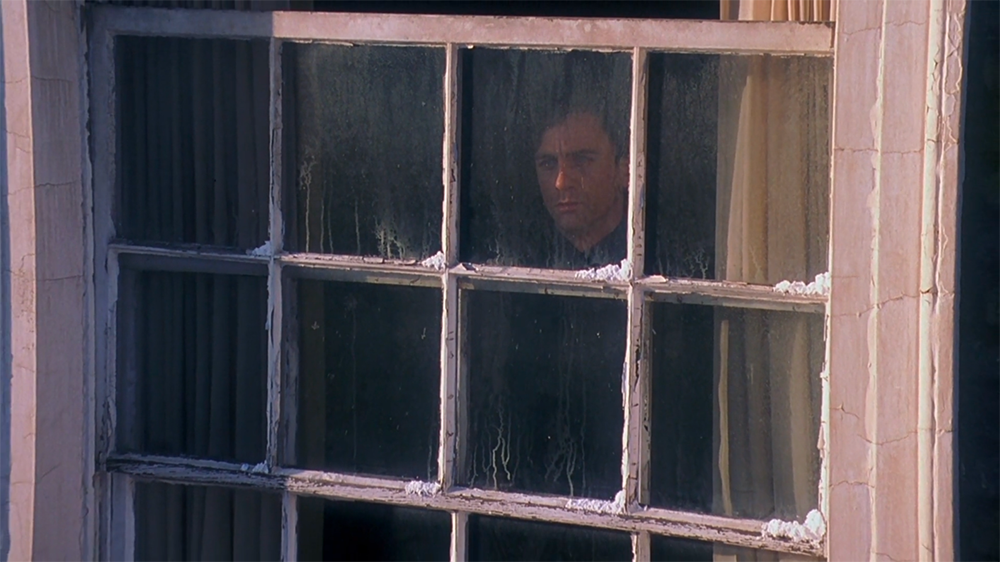
One can argue Hughes came to be defined by Plath, thus potentially justifying his centrality in a film about her life. As echoed by the aforementioned closing shot of him behind a window, Plath’s death effectively placed him inside the bell jar of her tragedy and unresolved anger. Yet for all the two influenced one another while alive as well as posthumously, it is reductive to have them voice that they are “not even two people” (Jeffs 2003) and merely “two halves” (ibid.). This line is fictitious and betrays the film’s wish to construct a neat narrative arc out of a pair of messy realities. Plath and Hughes, however, are perceived as inexorably linked more because of how they have been culturally received – Sylvia, after all, is itself a form of reception – than because of how they actually lived.
The film’s postscript is a good example of the tendency for Sylvia to manipulate truth, thus influencing audiences’ understanding of it. Reality is adapted not least in an attempt to create a film with a satisfying conclusion. Indeed, for her readers, the fact that Plath “will always be young and in a rage over Hughes’s unfaithfulness” (Malcolm 7) is part of what keeps her memory alive, yet Jeffs may have speculated this sense of irresolution would be unappealing to audiences, and thus chose not to translate it into film. Consequently, before the credits roll, a picture of a tree – previously seen in wintery bareness – is shown in full bloom as wistful, romantic piano music plays. Words then appear to inform the audience of the end of the true story supposedly depicted in Sylvia (see Figures 3 and 4). They read as follows:
On February 11th 1963 Sylvia Plath committed suicide.
She was found dead in her kitchen having inhaled gas from her stove.
A year later Ted Hughes oversaw the publications of her last manuscript of poems. The collection, ‘Ariel’, became one of the most celebrated and widely read books of poetry of the 20th century, and made Sylvia an icon to generations of readers.
In 1998, Ted Hughes broke a 30 year silence about Sylvia with the publication of ‘Birthday Letters’, a series of poems telling the story of their relationship. He died of cancer a few weeks later.
(Jeffs 2003)
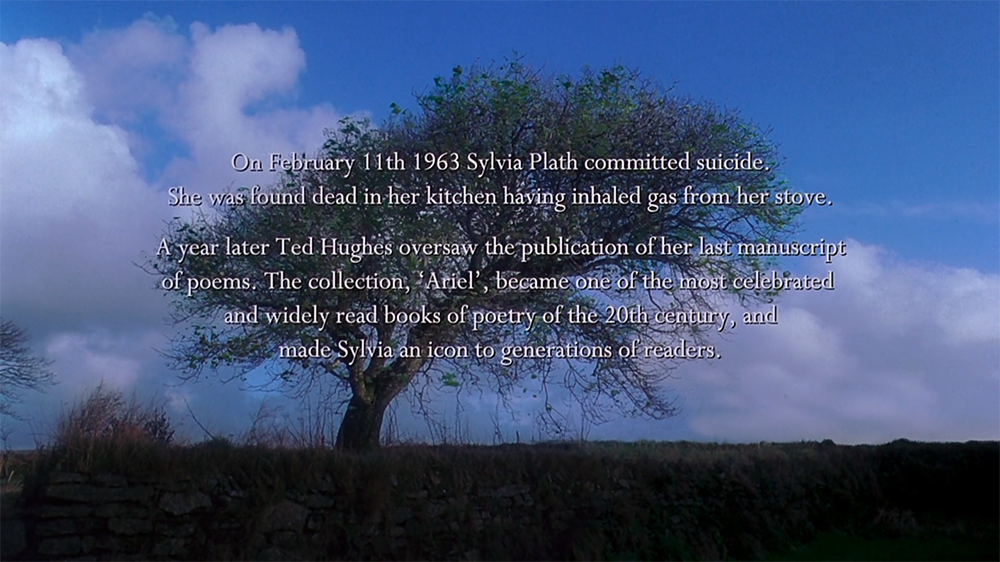
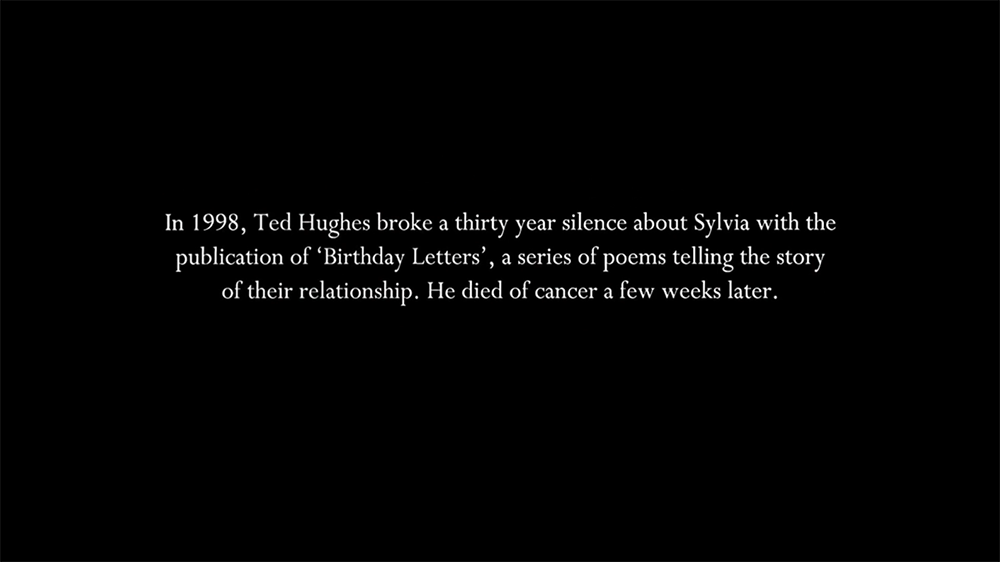
This postscript is problematic for several reasons. The placement of the writing at the end of the film coordinates it with audiences’ return to reality; coupled with the immediate mention of real dates regarding Plath’s death, the writing thus makes a claim to veracity. Yet this is troubling considering the half-truths expressed in the postscript’s second and third paragraphs. The second paragraph, for example, evokes Sylvia’s shot of Hughes laying his hand on the manuscript of Ariel (see Figure 5): judging by the postscript, the film potentially aims to make this seem like a protective gesture, especially as it is followed by a shot of Hughes kissing Plath’s forehead as she lies in her casket. Reality, however, can have the gesture take on a more ominous meaning. Scholar Andrew Wilson argues that “[Hughes’s] enormous shadow obscures many aspects of Plath’s life and work” (Wilson 4-5), for Hughes was Plath’s literary executor and censored her work – even destroying her last journals – at his own discretion. The postscript’s claim that he “oversaw” the publication of Ariel is thus euphemistic and borderline insulting to the integrity of Plath’s writing.
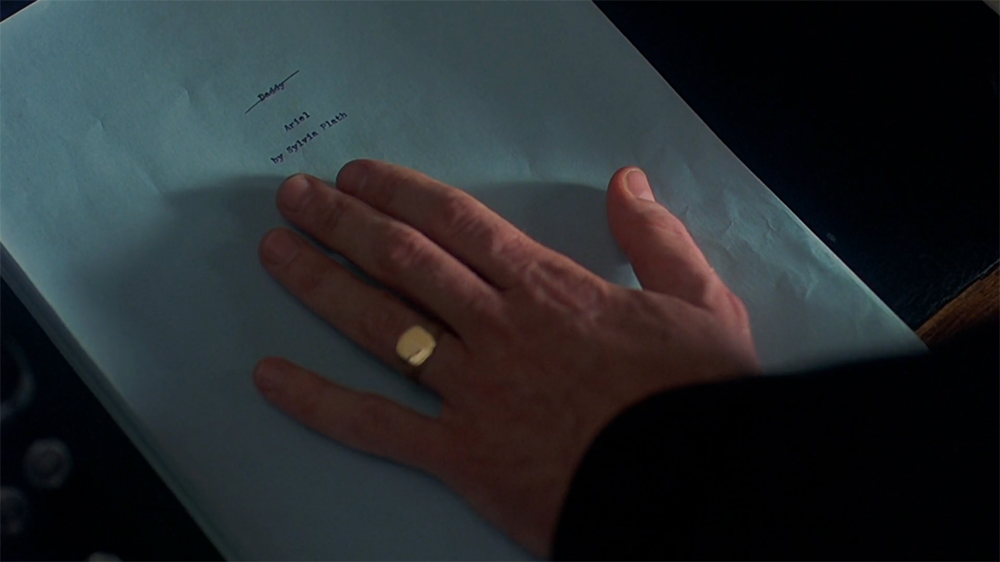
Why Sylvia elects to portray Hughes’s influence over Plath’s work in such a superficial light is questionable; one wonders whether the film’s production was impacted by considerations of how it might be received by the Hughes estate. Yet there also exists a simpler explanation for the film’s narrow ideation of Hughes’s role in Ariel’s publication: misogyny. In his foreword to Plath’s journals, for instance, Hughes claims Plath’s works preceding Ariel were “apprentice writings” (Hughes, “Foreword” xi). Such a view indicates Hughes may assume – somewhat arrogantly – that because Plath’s writing centers on anxiety over gender roles, all her work must have been created in reaction to men; and Ariel to him in particular, following their separation. Indeed, he claims Ariel reveals Plath’s “real self” (ibid. xii) and that this self only came into being after their marriage, implying that his wife’s self-actualization was facilitated by his presence. This attitude reflects feminist scholar Rita Felski’s observation that ‘women’s writing’ and fictions of female identity risk being shaped by context, “[a] text becom[ing] meaningful only insofar as it is read in relation to existing expectations governing [its] reception” (Felski 82). The way both Hughes and Sylvia interpret and frame Plath’s writing certainly supports this theory.
For a film which purports to celebrate and mourn the author and her talents, Sylvia’s script repeatedly undermines Plath’s creativity and independence of thought. The early beach vacation, for instance, shows Hughes encouraging and guiding Plath: he pressures her to write and helps her overcome writer’s block. This narrative choice in the film implies that writing came easier for Hughes than for Plath, as well as that he is at least partly responsible for Plath’s success owing to his coaching of her. Furthermore, this sentiment is reflected in the postscript, with the second paragraph describing how Ariel “became” celebrated only after noting that Hughes “oversaw” its publication (Jeffs 2003). As for Plath, meanwhile, the film shows her going from sitting lethargically at her desk, unable to write, to typing busily in the same room – walls now papered with poems and applications – following her encounter with Hughes. The insinuation is that he sparks her productivity and creativity. Indeed, this scene of bustling energy is replicated only towards the end of the film when he leaves her, and she is framed as writing her best work in reaction to his departure (see Figure 6).

The contrast between the postscript’s first two paragraphs and final paragraph also provides insight into how Sylvia chooses to streamline Plath’s life for the screen. Whereas the first two paragraphs – about Plath’s death and rise to icon status – are projected onto an image of a still, verdant tree, the third paragraph is projected onto a black background. This stands in stark contrast with the tree, which could be read as symbolic of life after death – spring after winter – and an encouragement to viewers to draw solace and a sense of conclusion from the fact that Plath may have died, but her memory will live on. Indeed, her fame flourished after her death; however, this was due not least to cultural romanticization and value placed on suicide, an act which thanatologists have argued can actually “add to [artists’] reputation as artists” (Shneidman 191). The film’s conclusive and near-uplifting approach to Plath’s suicide is therefore a reductive presentation of her death, reflecting little more than the disturbing link between suicide and artistic value in Western culture. This accusation of reductive understanding is merited, too, by the film’s acted interpretation of her suicide: it shows Paltrow’s peaceful face bathed in light before the shot fades out (see Figure 7), as though suggesting Plath renounced life with contentment and went to heaven. The fact she died with her head in the oven of a cold and dingy flat is glossed over. Such stylistic choices – both in the depiction of Plath’s death and the postscript – therefore indicate that the film engages with questionable modes of interpreting Plath rather than the truth of her situation.
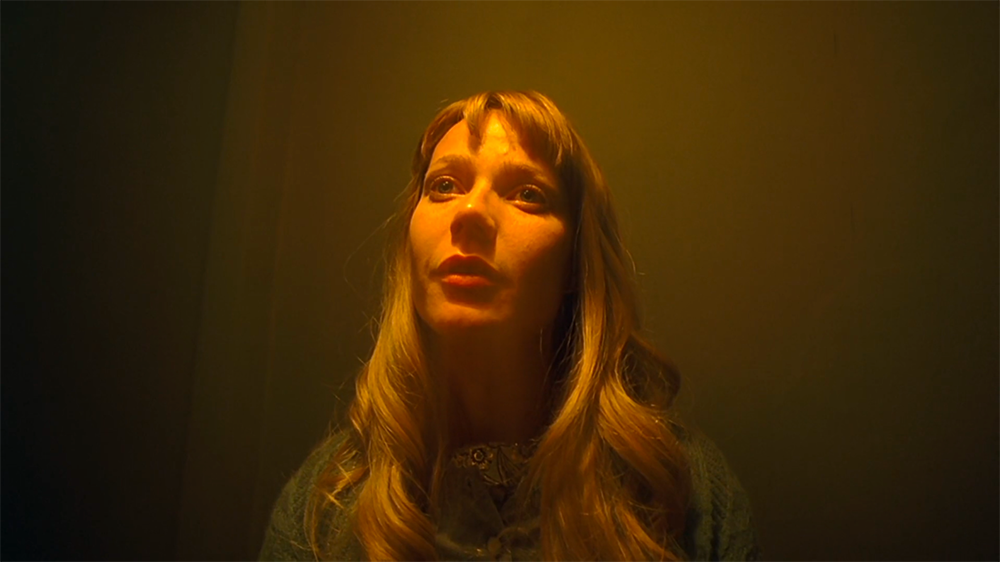
Sylvia’s questionable portrayal of Plath’s death is compounded by the fact it is the third paragraph of the postscript onto which viewers are encouraged to direct their concern. Coupled with the accompanying piano music’s change into a minor key, the visual difference of switching from a verdant tree to a black screen drives readers to attribute more gravity and sorrow to the paragraph on Hughes than to the one on Plath. Yet it is misleading of the film to employ visual and auditive cues to direct audiences’ sympathies in this manner. The final paragraph describes how Hughes apparently stayed silent about Plath for thirty years, eventually published a book of poems about their relationship, and died of cancer weeks later. What it fails to mention, however, is the fact that Hughes pursued other romantic relationships following Plath’s death, having affairs and even remarrying in 1970 (Feinstein 171); he remained married until his death in 1998. Along with the film’s final shot of Hughes at the window, the postscript insinuates via omission that Hughes pined after Plath until his death; however, this romanticized interpretation of their relationship is simply not true.
Moreover, any romanticization of Hughes and what he suffered by comparison to Plath is rendered especially troubling in light of recently emerged correspondence between Plath and her therapist, which alleges Hughes “beat [Plath] two days before she miscarried their second child and […] wanted her dead” (Kean 2017). Jeffs could not have known of this when she directed Sylvia; however, it was public knowledge that Plath had described her life with Hughes as “degraded and agonized” (Plath and Plath 460) and that Hughes’s mistress of the same era, Assia Wevill, had gassed both herself and Hughes’s illegitimate daughter Shura (Agarwal 134). Yet perhaps in part as a result of being women, neither Plath’s nor Wevill’s unhappiness appears to have been taken entirely seriously considering the degree to which Sylvia humanizes and even makes a victim of Hughes. Consequently, it is reasonable to conclude that the film fails to deliver an accurate, well-rounded biography of either Plath or Hughes, despite contextualizing itself as a biopic.
This is not to suggest one ought to demonize Hughes: the fact two women close to him committed suicide can be read in an overly sensationalist manner, considering these suicides do not necessarily prove anything about Hughes’s character. Nevertheless, it is reasonable to argue Plath’s repeated figuration of him as a panther who “stalks [her] down” (Plath, “Pursuit” 3) is not merely testament to “romantic glamorization” in her writing (Roberts 17). This threatening image – alluded to in Sylvia when Hughes climbs the stairs late at night with heavy tread – reflects the “violence” Plath detected in Hughes’s nature upon first meeting him (Plath and Kukil 212). Sylvia, however, repeatedly tones down this violence: the first meeting of Plath and Hughes, for example, is depicted as a tame dance with banter more reminiscent of Paltrow’s work in Emma than the reality of Plath’s life. In reality, the pair’s first encounter involved Hughes kissing Plath without consent, “bang smash on the mouth” (ibid.), and Plath biting him and drawing blood. Hughes’s “ruthless force” was thus apparent to Plath from the outset, unlike in the film (Plath and Kukil 570).
Onscreen, however, Hughes is shown to be angry only when provoked, which almost places responsibility for his outbursts with Plath. As for violence, the film typically frames any hints of this character trait as being indicative of a passionate, sexual nature – a simplistic interpretation. Indeed, the film takes such liberties with truth that it shows the pair’s relationship culminating in a reunion and sex scene which never occurred in real life; such is Jeffs’ commitment to the film’s “focus […] on a romantic love that lasts beyond death” (O’Sullivan 60). Yet this satisfying narrative arc, enabling the pair to discuss their grievances directly in a way they are not recorded as having done, has been included in the film for audience appeasement rather than historical accuracy.
Why is Jeffs making such directorial choices? Beyond her probable wish as a filmmaker to satiate audience’s needs for answers and resolution and thereby to make a financially successful film, it is possible she is influenced by stereotypes – especially ones linked to gender – which can manifest themselves in storytelling. As expressed by scholar Jörg Schweinitz, “stereotypes represent pre-existing fantasy values [and] structure the audience’s fantasies” (Schweinitz 98-99). Anyone who engages with stories at such a structural level through translating them into film, risks detecting or even seeking narrative conventions in the context of real life when producing stories for the screen. This certainly appears true of Jeff’s choices in her directing of Sylvia.
The film is somewhat dismissive and omissive of Plath’s misery in her relationship with Hughes, for instance, preferring to focus on the possibility that a tumultuous relationship equaled an uncommonly passionate and artistically fulfilling one. This is demonstrated in scenes such as that of a friend of the pair commenting how Plath and Hughes “understand one another in ways others can only dream about” (Jeffs 2003). The friend also encourages Plath not to abandon the relationship “just because of an affair” (ibid.). Yet these words are not recorded among the conversations in Plath’s journals, which suggests they reflect the filmmakers’ narrative agenda or even personal attitudes regarding how Plath ought to have behaved.
Such a possibility is concerning, for it indicates the filmmakers of Sylvia were influenced by posthumous mythologization of Plath’s and Hughes’s stormy romance and allowed this to interfere with their conveyance of truth. Indeed, Sylvia downplays Hughes’s repeated acts of infidelity both in conversations like the above and via emphasis on Daniel Craig’s acted regret, shown through a series of close-ups particularly following Plath’s death. This directorial decision was probably made with the aim of creating a pair of well-rounded characters; to foster narrative complexity through emphasizing how there were two sides to the story. Nevertheless, the side-effect of such a decision is that Sylvia arguably stretches truth in order to balance these two sides.
The idea that Sylvia twists reality to make it fit within the mold of a story is reminiscent of Linda Hutcheon’s arguments in A Theory of Adaptation. Hutcheon theorizes that the enjoyment audiences feel in watching film adaptations, whether these be adaptations of fiction or of reality, derives partly from “recognition and remembrance” (Hutcheon 4). This suggests that Sylvia may have been deliberately produced in accordance with familiar ideas about Plath for the sake of audience appeal. Furthermore, in adapting Plath’s life to the screen, Jeffs also made what Hutcheon terms “simplifying selections” (ibid. 3), which can have the added effect of amplifying and extrapolating particular elements of the truth. Consequently, it is unsurprising that Sylvia has adhered – whether deliberately or otherwise – to familiar storytelling structures, archetypes, and gender stereotypes. Indeed, these are arguably elements inherent to all forms of comprehension and reception. In order to process and synthesize information, an issue may be broken down into key points for practicality; however, this can engender the nuance existing between these points to be lost as the highlighted aspects of an issue are magnified, as they are in Sylvia.
Stereotyping in Sylvia is strongly evident in the characterization of Plath and Hughes. Perhaps in an unconscious bid to render these historical figures and characters easier to understand for audiences, the film magnifies roles within the pair’s relationship dynamic and makes Hughes active and Plath passive in accordance with gender stereotypes, a technique which does Plath in particular a disservice. She was notably ambitious, for instance, writing at a young age that “[her] thoughts to shining fame aspire[d]” (Plath, “Fireside Reveries”). Such a trait does not “conform to the essential feminine quality of niceness” (Connell 16) and indicates that Plath, like most people, was a mixture of traditionally masculine and feminine qualities. It also suggests she would have been unlikely to voice the words that Sylvia places in her mouth – that she “really feel[s] as though God is speaking through [her]” (Jeffs 2003) – instead of taking ownership of her creative powers. The film thus does the real Plath a disservice in its representation of her.
Indeed, through having Plath speak this invented line, Sylvia cements the idea that she is a vessel for writing: reactive, rather than creative. After all, even when the film shows her at her creative peak, frantically scribbling Ariel poems in a montage of writing shots, the scene is framed as reactive due to the scene in which Hughes leaves her having occurred directly beforehand. Moreover, along with the one other time poetry comes naturally to her during the film – when she and Hughes are in the boat at sea, and he is encouraging her – Sylvia makes it seem like Plath is almost possessed in her moments of creativity. In the boat scene, for example, water and music swell; the camera goes shaky; the audience is thus given a perception of instability and even otherworldly influence in Plath’s demeanor. These film techniques, however, merely reflect the film’s ongoing speculation that others, whether they be God or her husband, speak through Plath. Such insinuations are problematic, for they imply that Plath’s creativity is not wholly her own and is instead prompted by external factors like volatile husbands – a stereotype already present enough in Plath’s remembrance.
In this sense, the film reinforces not only stereotypes of feminine passivity but also the notion that women writers are ever constrained by having to “work within [a patriarchal cultural tradition] even as they question it” (Felski 46). While such a theory acknowledges a fundamental difficulty of being a female writer, it also does little to encourage the idea of an independent female literary canon forming – or even the idea that literature can be read outside of gender-based frameworks. Consequently, Sylvia perpetuates stereotypes of Plath not only through promulgating the notion that her life’s “central motif [is] Hughes’s betrayal” (Egeland 259), but also by gendering her writing process in accordance with limiting attitudes towards female authors. Indeed, the film’s framing of Plath’s writing plays into the outdated sexist idea that perhaps women writers can’t write quite in the same way as men. In this sense, therefore, Sylvia both echoes and propagates simplistic depictions of women, women writers, and Plath.
The film further stereotypes its leads by drawing on archetypes to tell its story. Plath, for instance, is established as a jealous wife: the disquieting soundtrack of buzzing bees as she speculates over Hughes’s unfaithfulness fosters the notion that her perception of his unfaithfulness is indicative of her instability and even madness. Thus, the film sets the scene for her to internalize blame for her marriage falling apart, exclaiming “It’s all my fault” (Jeffs 2003) to her neighbor, before adding of Wevill, “That woman… I conjured her. I invented her” (ibid.). The film’s insinuation is that, in the words of Sylvia’s Plath, “If you fear something enough, you can make it happen” (ibid.) – meaning that through her fear of losing Hughes, Plath drove him away and is therefore responsible for his infidelity.
The film takes this archetype even further. The visual medium of filmmaking allows Sylvia to magnify certain sexist interpretations of Plath and Hughes present in their receptions: it uses lighting and costume design to cast them in the roles of “evil enchantress” and “Byronic hero” respectively. Plath, for example, is figured as the Lady Lazarus of her poem by the same name (Plath, Ariel 16-19). Not only does her character talk of having died and then risen up again “like Lady Lazarus […] that’s me” (Jeffs 2003), but she also repeats this action onscreen. Indeed, after she decides to win Hughes back, she evokes an enchantress as she stands in greenish light before her bathroom mirror. Her hair hangs long; her hands are damp as though she has emerged from the sea following an attempt to drown herself; and unsettling, chiming music sounds as she carefully applies lipstick. This is symbolic of rebirth: she appears to be taking control of her life and seeking both sexual and creative emancipation. Nevertheless, the enchantress motif – enhanced by her earlier mention of having “conjured” Wevill – makes one question whether hers will be a demonic reincarnation as in her Lady Lazarus poem. What the film is truly alluding to here consciously or otherwise, therefore, is the sexist stereotype of women ensnaring men and keeping them captive within the constraints of relationships. The enchantress archetype merely facilitates this stereotype’s projection onto the screen in a visually intriguing way.
If Hughes is an archetype, meanwhile, it is that of the Byronic hero: dark, brooding, distant, and hyper-masculine. Indeed, his role in the film epitomizes “the hyperbole of the Byronic legend,” (Harris 58) showing him from the outset as an admittedly difficult person, but also an inherently magnetic and therefore valuable one. This is problematic, however, for when juxtaposed with the archetypes associated with Plath – that of the jealous wife and the evil enchantress – Hughes can suddenly appear almost artless in his tortured, Byronic identity. The film suggests he may even be a victim. Sylvia presents his predicament as a misfortune which has befallen him, for example, by showing him discussing how he wishes he could return to Plath but cannot owing to his obligations to the now-pregnant Wevill. Such a conundrum could even frame his decision to stay with Wevill as a sign of loyalty and honor – after all, the fictitious scene in which he returns to Plath and reaffirms their passionate connection makes it seem as though he ultimately stays with Wevill reluctantly. Yet such a representation of Hughes is misleading: as with the omissions in the film’s postscript, his characterization towards the film’s ending as a tortured and tragic soul patently overlooks his active role in creating the unpleasant situation he is forced to navigate.
This leads to a broader question: namely, what does the translation of Plath and Hughes into stereotypes and archetypes say about how they are received? It has been established that the familiarity offered by simplistic, stereotypical interpretations can have audience appeal. It is also clear that gender plays a role in how these stereotypes are identified and emphasized in characterization. Reflection on the fact Plath has been chosen to figure in Sylvia as passive, unstable, and stereotypically feminine, however, could reveal a key truth about why she has endured as an author and continues to be revisited in pop culture.
Although Plath is widely considered by scholars to be a ground-breaking feminist author whose unpredictable, often unsettling writing indicates subversiveness of thought, it is possible she has been canonized to the extent that she has in part because films like Sylvia are disturbingly adept at containing her within belittling biographies. Elements of her person and her life render her relatively easily figured as traditionally feminine, non-threatening, and even conservative, especially to audiences who have not actually read her writing – and who may, too, carry with them limited ideas regarding how a ‘female poet’ is. Feminist critics rightly emphasize that Plath is noteworthy for her “courage to be unpleasant” (Malcolm 32) in her writing. Nevertheless, it is possible Plath is culturally long-lasting, at least in the general public’s imagination, in no small part because of her perceived adherence to stereotypes about female weakness and tragedy as opposed to for her writing’s radical attributes. Indeed, gendered biases in interpreting Plath’s death patronize her and her writing, thus arguably making her conventional and safe enough to represent onscreen as in a mainstream film. The “recurring association between femininity and death” (Heinämaa 74) potentially frames her suicide as feminine, for example: it consolidates views of her as fragile, anxious, vulnerable, and thus stereotypically female. Such perceptions are only magnified by interpretations of Plath’s life in accordance with stereotypes which simultaneously cast her as a beautiful young martyr and a tortured madwoman. The ease with which Plath can be linked to conventional and reductive stereotypes about women, therefore, may serve to mute the more radical aspects present in her person and her writing, such as the violent hatred expressed by the semi-autobiographical protagonist of The Bell Jar towards her mother (Plath, The Bell Jar 130). Consequently, it is likely Plath’s reception – and its influence on reinterpretations of her life as in Sylvia – is impacted in large part by the fact elements of her life can be figured as conventional.
This point in turn answers the question of why Sylvia was made in the first place.
Audiences not only gain satisfaction from seeing their preconceived ideas about Plath being projected onscreen, but they also enjoy the challenge that Plath as a figure simultaneously does and does not offer. She and her work push boundaries enough to be distinctive – even to historically male literary gatekeepers, hence her propensity to be canonized – but not so much that she necessarily confronts audiences, especially modern ones familiar with her tale. Consequently, audiences can feel as though they are watching a story which is highbrow, weighty, or radical in some way, yet the film itself is a comfortable spectacle for Plath’s “peanut-crunching crowd” (Plath, Ariel 17).
To elicit emotion among sedate, peanut-crunching audiences, Sylvia resorts to depicting Plath’s tragedy in a grotesque and fetishized manner. The scene in which Plath’s suicide is discovered, for example, is shown in grave slow motion with her children’s tears and confusion center-screen (see Figure 8). Sylvia thus panders to the voyeurism of Plath’s insatiable audience. Jeffs and Focus Features would have known from the pre-production stage that people would attend the film if just for the opportunity to peek into Plath’s and Hughes’s oblique and debated relationship, hoping to uncover something new. Indeed, the film’s ‘biopic’ genre promises insight, misleading though this promise may be. Consequently, one can see why Frieda Hughes has responded to the alignment of her mother’s image with “the often grotesque aesthetic of celebrity culture” (Bayley and Brain 6) by denouncing creations like Sylvia. She opposes audiences’ voyeurism, decrying how “since she died [her] mother has been dissected, analyzed, reinterpreted, reinvented, fictionalized, and in some cases completely fabricated” (Hughes, “Foreword to Sylvia Plath” xx). This response highlights the fundamental problem of all reinterpretations of Plath and her life: that no matter the intentions with which these productions are conceived, or how true they market their stories as being, they can never claim to represent Plath free of reception’s bias. Interpretations of Plath like Sylvia will always be forms of reception more than they are a means of illuminating an issue or a life. Indeed, they ultimately illuminate culture’s response to Plath rather than Plath herself.
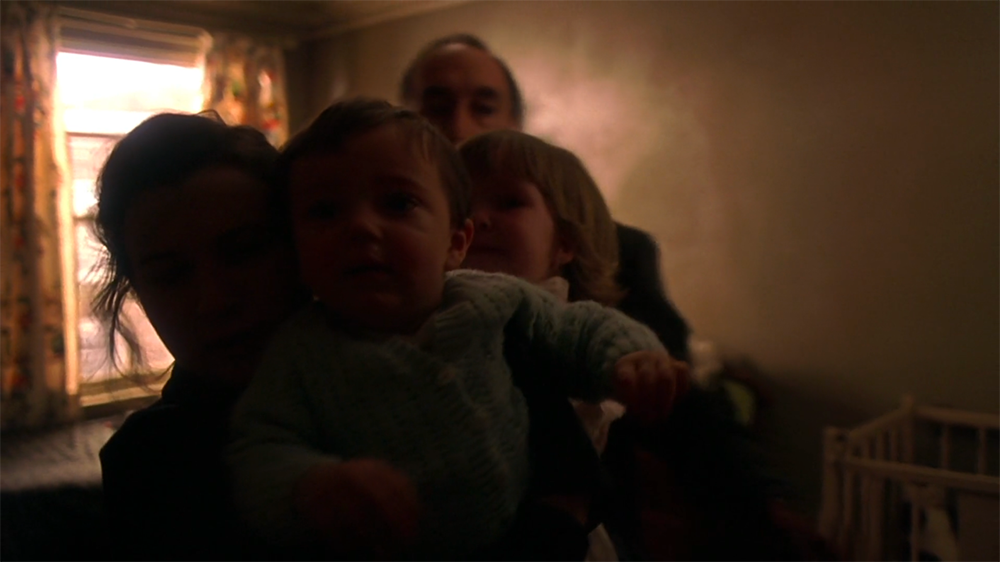
The promotion of Christine Jeffs’s Sylvia as an insightful biopic may attract wide audiences, from those with a scholarly interest in Plath to those who have heard her name or are interested in tragic romance, but, in the end, it poses more questions than it delivers answers. Through paratexts and casting, stereotyping, and capitalization on preconceived ideas surrounding Plath and Hughes, the film perpetuates the reductive and gendered reception of Plath which figures her as passive and stereotypically feminine. Indeed, Sylvia merely entrenches an understanding of Plath which emphasizes those aspects of her most easily interpretable as conventional, thus overshadowing the more radical and challenging elements of her work and person. Analyzing the film may consequently appear to be a study in pointlessness; however, assessing why the film was made and how its protagonists are portrayed can help explain Plath’s legacy. By examining the flaws and limitations of Plath’s reception as it stands, it may be possible to foster awareness of how Plath’s modern-day memory is constructed. This could in turn engender more nuanced understanding and representation of her in the future.
Works Cited
Agarwal, Suman. Sylvia Plath. New Delhi: Northern Book Centre, 2003.
Bayley, Sally, and Brain, Tracy. “Introduction.” In Representing Sylvia Plath. Edited by Sally Bayley and Tracy Brain. New York: Cambridge University Press, 2011, 1-9.
Brain, Tracy. “Fictionalizing Sylvia Plath.” In Representing Sylvia Plath. Edited by Sally Bayley and Tracy Brain. New York: Cambridge University Press, 2011, 183-202.
Connell, Elaine. Sylvia Plath: Killing the Angel in the House. Hebden Bridge: Pennine Pens, 1993.
“Daniel Craig.” The Internet Movie Database. November 3, 2017. Accessed 30 October, 2022. http://www.imdb.com/name/nm0185819/.
Ebert, Roger. “Reviews: Sylvia.” RogerEbert.com. October 24, 2003. Accessed 30 October, 2022. https://www.rogerebert.com/reviews/sylvia-2003.
Egeland, Marianne. Claiming Sylvia Plath: The Poet as Exemplary Figure. Newcastle upon Tyne: Cambridge Scholars Publishing, 2013.
Emma. Directed by Douglas McGrath. Santa Monica: Miramax Films, 1996. DVD, 120 min.
Feinstein, Elaine. Ted Hughes: The Life of a Poet. New York: W. W. Norton and Company, 2003.
Felski, Rita. Beyond Feminist Aesthetics. Cambridge: Harvard University Press, 1989.
Focus Features, “Sylvia movie posters.” In Sylvia 2003. Cinematerial.com, 2003. Posters. Accessed 30 October, 2022. https://www.cinematerial.com/movies/sylvia-i325055.
Focus Features, “Sylvia Japanese movie poster.” In Sylvia 2003. Cinematerial.com, 2003. Poster. Accessed 10 February, 2023. https://www.cinematerial.com/movies/sylvia-i325055/p/scxrlvit.
Focus Features, “Sylvia South Korean movie poster.” In Sylvia 2003. Cinematerial.com, 2003. Poster. Accessed 10 February, 2023. https://www.cinematerial.com/movies/sylvia-i325055/p/imzyc0bl.
Focus Features, “Sylvia Spanish movie poster.” In Sylvia 2003. Cinematerial.com, 2003. Poster. Accessed 10 February, 2023. https://www.cinematerial.com/movies/sylvia-i325055/p/uyaiu0mq.
Focus Features, “Sylvia Swedish movie poster.” In Sylvia 2003. Cinematerial.com, 2003. Poster. Accessed 10 February, 2023. https://www.cinematerial.com/movies/sylvia-i325055/p/vn97dza2.
Focus Features, “Sylvia Taiwanese movie poster.” In Sylvia 2003. Cinematerial.com, 2003. Poster. Accessed 10 February, 2023. https://www.cinematerial.com/movies/sylvia-i325055/p/07fdm7wb.
Focus Features, “Sylvia United States movie poster.” In Sylvia 2003. Cinematerial.com, 2003. Poster. Accessed 30 October, 2022. https://www.cinematerial.com/movies/sylvia-i325055/p/uwzqbhab.
Great Expectations. Directed by Alfonso Cuarón. Los Angeles: Art Linson Productions, 1998. DVD, 111 min.
Harris, Siân. “‘Mad, bad and dangerous to know’: the male poet in Sylvia (2003) and The Edge of Love (2008).” In The Writer on Film: Screening Literary Authorship. Edited by Judith Buchanan. London: Palgrave Macmillan, 2013, 55-65.
Heinämaa, Sara. “The Sexed Self and the Mortal Body.” In Birth, Death, and Femininity: Philosophies of Embodiment. Edited by Robin May Schott. Bloomington: Indiana University Press, 2010, 73-97.
Hughes, Frieda. “Foreword to Sylvia Plath.” Foreword to Ariel: The Restored Edition, by Sylvia Plath. New York: HarperCollins, 2004, xi-xxi.
Hughes, Ted. Birthday Letters. London: Faber and Faber, 1998.
Hughes, Ted. “Foreword.” The Journals of Sylvia Plath. Edited by Ted Hughes. New York: Anchor Books, 1982, xi-xiii.
Hutcheon, Linda. A Theory of Adaptation. New York and Abingdon: Routledge, 2006.
Kean, Danuta. “Unseen Sylvia Plath letters claim domestic abuse by Ted Hughes.” The Guardian, April 12, 2017. Accessed 30 October, 2022. https://www.theguardian.com/books/2017/apr/11/unseen-sylvia-plath-letters-claim-domestic- abuse-by-ted-hughes.
Larkin, Philip. “Letter to Robert Conquest: 15 June 1975.” In Selected Letters of Philip Larkin: 1940-1985. Edited by Anthony Thwaite. London: Faber and Faber, 1993, 318-320.
LeFebvre, Nichole. “A Tale of Two Sylvias: On the Letters Cover Controversy.” Literary Hub, October 3, 2017. Accessed 30 October, 2022. http://lithub.com/a-tale-of-two-sylvias-on-the-controversy-surrounding-two-new-letters- covers/.
Malcolm, Janet. The Silent Woman. New York: Alfred A. Knopf, 1995. O’Sullivan, Charlotte. “Review: Sylvia.” Sight and Sound 14(2), 2004, 60-62. Plath, Sylvia. Ariel. London: Faber and Faber, 1965.
Plath, Sylvia. “Fireside Reveries.” In Plath Manuscripts. Lilly Library, Indiana University, Bloomington, Indiana; Box 14, Folder 8.
Plath, Sylvia. “Pursuit.” In Sylvia Plath: Collected Poems. Edited by Ted Hughes. London: Faber and Faber, 1981, 3-4.
Plath, Sylvia. The Bell Jar. London: Faber and Faber, 1963.
Plath, Sylvia. The Letters of Sylvia Plath Volume I: 1940-1956. Edited by Kukil, Karen V., and Steinberg, Peter K. New York: Anchor Books, 2000.
Plath, Sylvia, and Kukil, Karen V. The Unabridged Journals of Sylvia Plath, 1950-1962. New York: Anchor Books, 2000.
Plath, Sylvia, and Plath, Aurelia. Letters home: correspondence, 1950-1963. New York: Harper & Row, 1975.
Roberts, Neil. Reading Ted Hughes: ‘New Selected Poems’. Penrith: Humanities- Ebooks.co.uk, 2008.
Schweinitz, Jörg. Film and Stereotype: A Challenge for Cinema and Theory. New York, Columbia University Press, 2011.
Shakespeare in Love. Directed by John Madden. Santa Monica: Miramax Films, 1998. DVD, 123 min.
Shneidman, Edwin S. Lives and Deaths: Selections from the Works of Edwin S. Shneidman. Ann Arbor: Braun-Brumfield, 1999.
Sylvia. Directed by Christine Jeffs. Universal City: Focus Features, 2003. DVD, 100 min.
“Sylvia.” The Internet Movie Database. October 31, 2003. Accessed 30 October, 2022. http://www.imdb.com/title/tt0325055/.
Wilson, Andrew. Mad Girl’s Love Song. London: Simon & Schuster, 2013.